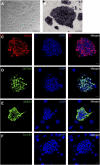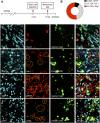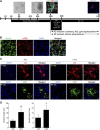Protein-Induced Pluripotent Stem Cells Ameliorate Cognitive Dysfunction and Reduce Aβ Deposition in a Mouse Model of Alzheimer's Disease
- PMID: 28170178
- PMCID: PMC5442740
- DOI: 10.5966/sctm.2016-0081
Protein-Induced Pluripotent Stem Cells Ameliorate Cognitive Dysfunction and Reduce Aβ Deposition in a Mouse Model of Alzheimer's Disease
Abstract
Transplantation of stem cells into the brain attenuates functional deficits in the central nervous system via cell replacement, the release of specific neurotransmitters, and the production of neurotrophic factors. To identify patient-specific and safe stem cells for treating Alzheimer's disease (AD), we generated induced pluripotent stem cells (iPSCs) derived from mouse skin fibroblasts by treating protein extracts of embryonic stem cells. These reprogrammed cells were pluripotent but nontumorigenic. Here, we report that protein-iPSCs differentiated into glial cells and decreased plaque depositions in the 5XFAD transgenic AD mouse model. We also found that transplanted protein-iPSCs mitigated the cognitive dysfunction observed in these mice. Proteomic analysis revealed that oligodendrocyte-related genes were upregulated in brains injected with protein-iPSCs, providing new insights into the potential function of protein-iPSCs. Taken together, our data indicate that protein-iPSCs might be a promising therapeutic approach for AD. Stem Cells Translational Medicine 2017;6:293-305.
Keywords: 5XFAD mice; Alzheimer's disease; Oligodendrocyte; Protein-iPSC; Proteomic analysis.
© 2016 The Authors Stem Cells Translational Medicine published by Wiley Periodicals, Inc. on behalf of AlphaMed Press.
Figures






References
-
- Querfurth HW, LaFerla FM. Alzheimer's disease. N Engl J Med 2010;362:329–344. - PubMed
-
- Citron M. Alzheimer's disease: Strategies for disease modification. Nat Rev Drug Discov 2010;9:387–398. - PubMed
-
- Benilova I, Karran E, De Strooper B. The toxic Aβ oligomer and Alzheimer's disease: An emperor in need of clothes. Nat Neurosci 2012;15:349–357. - PubMed
Publication types
MeSH terms
Substances
LinkOut - more resources
Full Text Sources
Other Literature Sources
Medical

